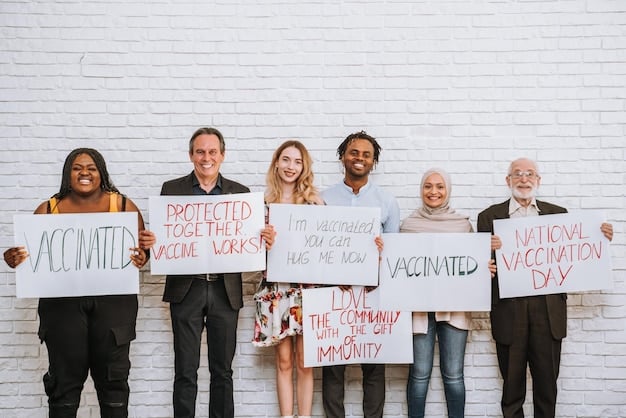Analyzing the Effectiveness of US Hate Crime Laws in 2025

Analyzing the Effectiveness of Current US Hate Crime Legislation: Are Protections Adequate in 2025? This article delves into whether existing hate crime laws sufficiently protect vulnerable groups, considering evolving societal contexts and legal challenges.
Are current hate crime laws in the United States truly effective in protecting those most vulnerable? The question of analyzing the effectiveness of current US Hate Crime Legislation: Are Protections Adequate in 2025? demands a comprehensive look at the legal landscape and its practical application.
This article seeks to explore these issues, examining the strengths and weaknesses of existing protections and considering possible reforms.
Analyzing the Effectiveness of US Hate Crime Legislation: A 2025 Perspective
The effectiveness of hate crime legislation is a topic of ongoing debate, particularly when analyzing the effectiveness of current US Hate Crime Legislation: Are Protections Adequate in 2025? This section will explore the historical context, current laws, and challenges in their enforcement.
Historical Context
Hate crime legislation in the US has evolved significantly over time, reflecting changing societal attitudes and legal interpretations.
- The first federal hate crime law was passed in 1968, primarily aimed at protecting civil rights workers.
- The Hate Crime Statistics Act of 1990 mandated the collection of data on hate crimes.
- The Matthew Shepard and James Byrd Jr. Hate Crimes Prevention Act of 2009 expanded federal law to include crimes motivated by sexual orientation, gender identity, and disability.
These historical milestones highlight the ongoing effort to address bias-motivated violence and intimidation.

Current Federal and State Laws
Both federal and state governments have enacted laws to address hate crimes, creating a complex patchwork of protections.
- Federal law provides broader jurisdiction, particularly in cases involving interstate commerce or federal property.
- State laws often offer more specific protections based on local needs and demographics.
- Many states have laws that mirror federal statutes, while others provide additional categories of protected characteristics.
Differences in state laws can lead to disparities in prosecution and sentencing, raising questions about equal protection under the law.
In summary, understanding the historical development and current legal framework is crucial for analyzing the effectiveness of current US Hate Crime Legislation: Are Protections Adequate in 2025? The next section will delve into challenges and criticisms related to these laws.
Challenges and Criticisms of Hate Crime Laws
Despite the existence of hate crime laws, their effectiveness is often questioned due to various challenges and criticisms when analyzing the effectiveness of current US Hate Crime Legislation: Are Protections Adequate in 2025? These issues range from difficulties in proving motive to concerns about free speech.
Proving Motive
One of the biggest hurdles in prosecuting hate crimes is proving that the crime was motivated by bias.
Prosecutors must demonstrate beyond a reasonable doubt that the offender’s actions were driven by prejudice against a protected characteristic.
This can be challenging, as offenders may not explicitly state their motive or may offer alternative explanations for their actions.
First Amendment Concerns
Critics argue that hate crime laws can infringe on First Amendment rights to freedom of speech and expression.
They contend that the government should not punish individuals for their beliefs, even if those beliefs are hateful or offensive.
The line between protected speech and criminal conduct can be blurry, leading to legal challenges and varying interpretations by the courts.
Data Collection and Reporting Issues
Accurate data collection is essential for understanding the scope and nature of hate crimes, but significant challenges exist.
- Many hate crimes go unreported due to fear, distrust of law enforcement, or lack of awareness.
- Data collection methods may vary across jurisdictions, making it difficult to compare statistics and identify trends.
- The definition of “hate crime” can be subjective, leading to inconsistent reporting practices.
Addressing these challenges requires improved data collection methods, increased community outreach, and enhanced training for law enforcement.
In essence, despite the intention behind hate crime laws, proving motive, First Amendment concerns, and data collection issues pose significant challenges in analyzing the effectiveness of current US Hate Crime Legislation: Are Protections Adequate in 2025? The next section will explore the impact of hate crimes on victims and communities.
Impact of Hate Crimes on Victims and Communities
Hate crimes have a devastating impact not only on individual victims but also on entire communities. Analyzing the effectiveness of current US Hate Crime Legislation: Are Protections Adequate in 2025? should consider the broad consequences of these acts.

Psychological and Emotional Trauma
Victims of hate crimes often experience severe psychological and emotional trauma.
The intentional targeting based on identity can lead to feelings of vulnerability, fear, and isolation.
Many victims suffer from anxiety, depression, and post-traumatic stress disorder (PTSD).
Communitywide Effects
Hate crimes can create a climate of fear and distrust within targeted communities.
- These crimes can discourage people from participating in public life or expressing their identities openly.
- Hate incidents can strain relationships between different groups and undermine social cohesion.
- Communities may experience economic harm as businesses and residents relocate due to safety concerns.
Understanding the far-reaching effects of hate crimes is crucial for developing effective prevention and response strategies.
Intersectionality
It is important to recognize that individuals can experience hate crimes based on multiple intersecting identities.
For example, a person may be targeted due to their race, gender, and sexual orientation.
Analyzing the effectiveness of current US Hate Crime Legislation: Are Protections Adequate in 2025? requires an intersectional approach that acknowledges the complex ways in which bias can manifest.
In this context, understanding the psychological trauma, community-wide effects, and the role of intersectionality, is key when analyzing the effectiveness of current US Hate Crime Legislation: Are Protections Adequate in 2025? The next section will delve into potential reforms and solutions.
Potential Reforms and Solutions
To enhance the effectiveness of hate crime legislation, several reforms and solutions should be considered. These include strengthening laws, improving data collection, and promoting education and awareness. Analyzing the effectiveness of current US Hate Crime Legislation: Are Protections Adequate in 2025? demands innovative approaches to combat hate.
Strengthening Existing Laws
One approach is to strengthen existing hate crime laws by expanding protected categories and increasing penalties.
Some states may consider adding gender identity, immigration status, and other characteristics to their list of protected attributes.
Increasing penalties for hate crimes can send a strong message that bias-motivated violence will not be tolerated.
Improving Data Collection and Reporting
Accurate and comprehensive data collection is essential for understanding the scope and nature of hate crimes.
- Law enforcement agencies should adopt standardized reporting protocols and training programs.
- Community-based organizations can play a vital role in encouraging victims to report hate crimes.
- Data should be disaggregated by protected characteristic to identify trends and inform targeted interventions.
Enhanced data collection can help policymakers and law enforcement agencies better understand and address hate crimes.
Promoting Education and Awareness
Education and awareness campaigns can help prevent hate crimes by fostering tolerance, respect, and understanding.
Schools, workplaces, and community organizations can implement programs that promote diversity and inclusion.
Public service announcements and media campaigns can raise awareness about the impact of hate crimes and encourage reporting.
In short, strengthening existing laws, improving data collection, and promoting education and awareness are crucial steps for analyzing the effectiveness of current US Hate Crime Legislation: Are Protections Adequate in 2025? The final section before the conclusion will explore community and advocacy efforts.
Community and Advocacy Efforts
Community and advocacy groups play a crucial role in combating hate crimes and supporting victims. Analyzing the effectiveness of current US Hate Crime Legislation: Are Protections Adequate in 2025? requires understanding the contributions of these organizations.
Support for Victims
Many organizations provide direct support to victims of hate crimes, offering counseling, legal assistance, and advocacy.
These services can help victims cope with the trauma they have experienced and navigate the legal system.
Support groups and peer networks can also provide a sense of community and solidarity.
Advocacy for Policy Change
Advocacy groups work to promote policy changes that will strengthen hate crime laws and protect vulnerable groups.
- They lobby lawmakers to pass legislation that expands protected categories and increases penalties.
- They advocate for improved data collection and reporting practices.
- They work to raise awareness about hate crimes and their impact on communities.
These efforts are essential for creating a more just and equitable society.
Community Organizing
Community organizing can empower local residents to address hate crimes and promote tolerance.
Organizers work to build relationships between different groups and create a sense of shared responsibility for combating hate.
Community-based initiatives can include bystander intervention training, restorative justice programs, and community dialogues.
Ultimately, support for victims, advocacy for policy change, and community organizing are significant elements for analyzing the effectiveness of current US Hate Crime Legislation: Are Protections Adequate in 2025?
| Key Point | Brief Description |
|---|---|
| ⚖️ Legal Framework | Federal and state laws addressing hate crimes and bias-motivated violence. |
| 💔 Impact on Victims | Psychological and emotional trauma experienced by individuals targeted in hate crimes. |
| 🛡️ Potential Solutions | Strengthening laws, improving data collection, and promoting education to prevent hate crimes. |
| 🤝 Community Efforts | Community and advocacy groups supporting victims and promoting policy change. |
Frequently Asked Questions
Hate crime laws are statutes that enhance penalties for crimes motivated by bias against a victim’s race, religion, sexual orientation, or other protected characteristic. Analyzing the effectiveness of current US Hate Crime Legislation: Are Protections Adequate in 2025? requires understanding these statutes.
A hate crime is distinguished by the offender’s intent to target a victim based on their membership in a protected group. This bias motivation elevates the severity of the offense.
Accurate data collection helps to understand the prevalence and nature of hate crimes. This information is crucial for informing policy and allocating resources effectively when analyzing the effectiveness of current US Hate Crime Legislation: Are Protections Adequate in 2025?
If you witness a hate crime, report it to law enforcement immediately. You can also offer support to the victim and connect them with resources.
Potential reforms include expanding protected categories, increasing penalties, and improving data collection. These reforms aim to strengthen protections and ensure justice when analyzing the effectiveness of current US Hate Crime Legislation: Are Protections Adequate in 2025?
Conclusion
In conclusion, analyzing the effectiveness of current US Hate Crime Legislation: Are Protections Adequate in 2025? requires a multifaceted approach. Strengthening laws, improving data collection, and promoting community support are essential for combating hate and protecting vulnerable groups.
Ongoing dialogue and collaboration between policymakers, law enforcement, and community organizations will be critical in ensuring that hate crime laws are effective and just.





